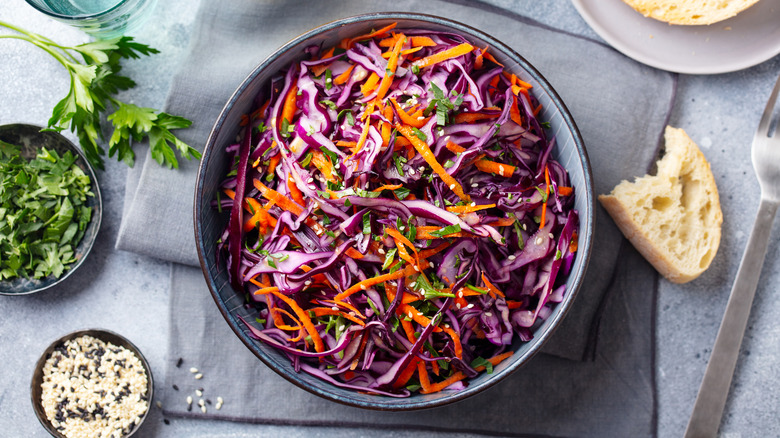What's The Actual Difference Between Cabbage Salad And Coleslaw?
It takes extra work, but a meal just feels more well-rounded when you serve a side dish next to your main. When chosen carefully, your sides provide a complementary counterpoint to the entrée in terms of flavors, textures, and colors so your palate gets refreshed in between bites. They're also great ways of incorporating more vegetables into your meals. Cabbage is a wonderful choice for making a variety of quick and tasty recipes that are nutritious and don't break your budget. Two of the most popular (if not frequently interchanged) sides that you can make with this veggie are cabbage salad and coleslaw.
Both feature shredded raw cabbage mixed with other vegetables, particularly carrots, to create a crunchy, colorful plate. The difference lies in the dressing each dish uses: Coleslaw uses a creamier one, usually mayonnaise mixed with vinegar plus a few spices, while cabbage salad is served with a much lighter vinaigrette. While other ingredients can be added to either dish to give them a more complex flavor, that difference in dressing is the main factor that distinguishes the two and is a crucial component when deciding which side to serve in a meal.
The use of mayonnaise also raises the caloric and fat content of a typical coleslaw higher than a cabbage salad. Other than this difference, cabbage salad and coleslaw are equally great and nutrient-packed choices for side dishes. Make your next meal more satisfying by choosing the right cabbage dish to serve with it.
What is a cabbage salad?
Its use of vinaigrette makes cabbage salad a refreshing accompaniment to delicately flavored grilled fish and seafood and to crispy fried pork and chicken. The vinegar's acidity is balanced by the nuttiness of the olive oil, and the addition of matchstick carrots injects a light sweetness that can counter the natural bitterness of raw cabbage. You can also season the dressing with sweeteners according to your taste and even switch up its flavor profile to fit in with a particular cuisine. Our Napa cabbage salad recipe mixes soy sauce, garlic powder, honey, sesame oil, and rice vinegar for an Asian-inspired sweet, nutty, and umami-packed dressing that highlights the freshness of the vegetables.
Because of its light dressing, cabbage salad has a more pronounced crunchiness to it, which is part of its appeal. Shred the cabbage so you can add the salad to a burrito bowl or use it as a topping for fish tacos. For a proper side salad, slice the cabbage into bite-sized pieces so each forkful has a dynamic play of textures between the ingredients. You can also incorporate this dish into a more complex bowl. Use a crunchy purple cabbage salad as a colorful base and then give it a twist by tossing in edamame and toasted almonds. For a complementary dressing, mix ponzu and toasted sesame oil together then add a splash of lemon juice. Serve your cabbage salad with crispy pork loin tonkatsu for an delicious Japanese-themed meal.
What is coleslaw?
A favorite side to serve with a wide array of dishes, from burgers to glazed chicken wings, coleslaw's use of a creamy dressing lends it a rich yet tangy flavor that perfectly accompanies meat. The smooth and thick consistency of the dressing also works to balance the peppery heat released by other seasonings, which is why it's great to have around when you're serving spicy grilled ribs. There's a variety of ways to boost coleslaw's flavor, and its versatility makes it a staple in every Southern-style barbecue. From an extra-crunchy side dish tossed with toasted pecans to the zesty Creole-style coleslaw that switches the mayonnaise for mustard, it's easy to adapt its flavor to complement an entrée.
Since this dish is served cold, most people stick to shredding raw cabbage and mixing it with the other ingredients. However, cooking the cabbage first caramelizes the vegetable and unlocks a smoky sweetness that will elevate your classic coleslaw. Before mixing it with the dressing and other vegetables, you can sauté, fry, roast, or grill the cabbage, depending on how much cooking time you have, and be confident that the extra layer of flavor created by the heat won't compromise its crunchy texture. Just make sure you don't add water to the cabbage while cooking it and you don't keep it on the stove or the grill for too long so it doesn't get soggy.


